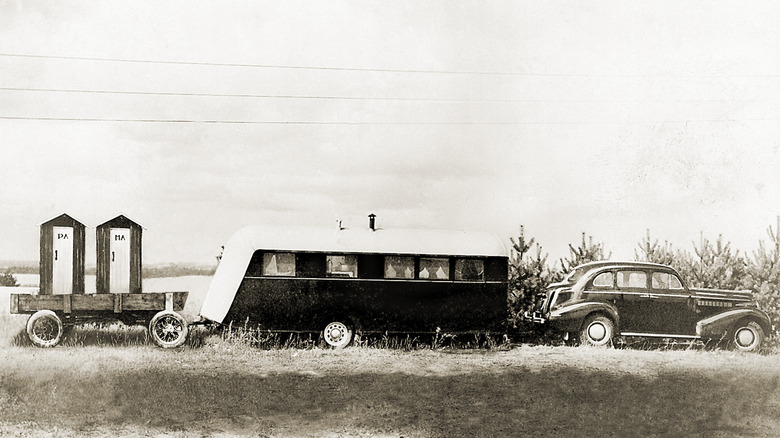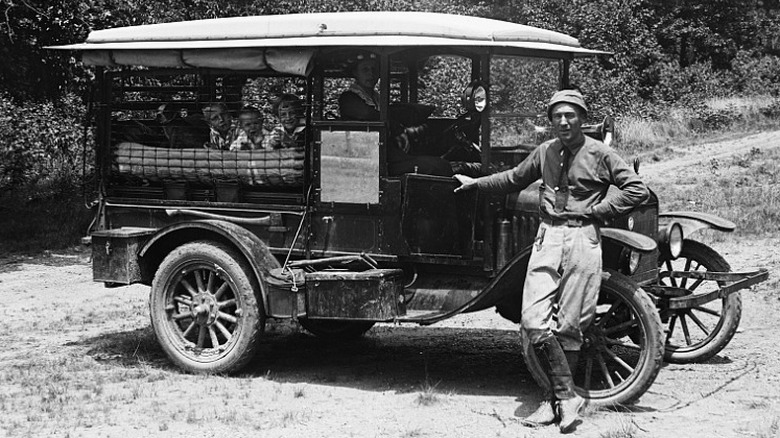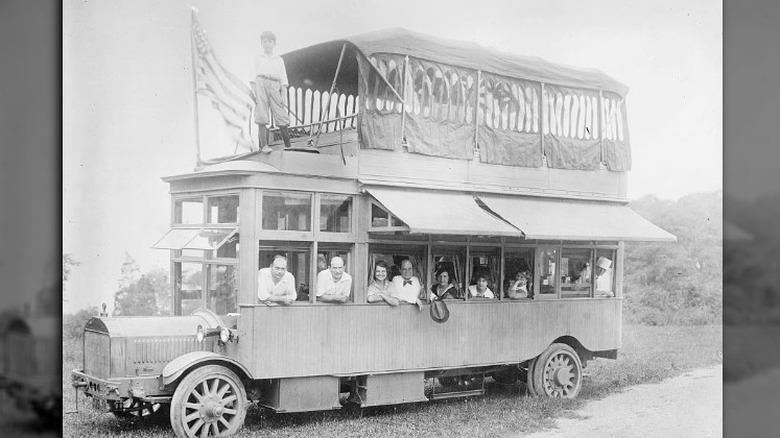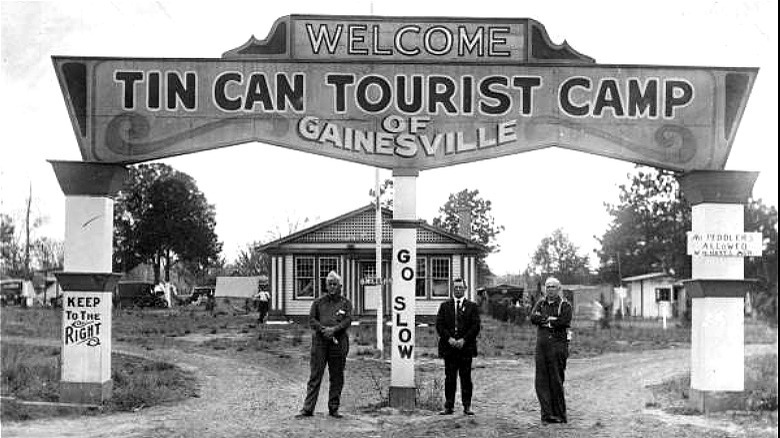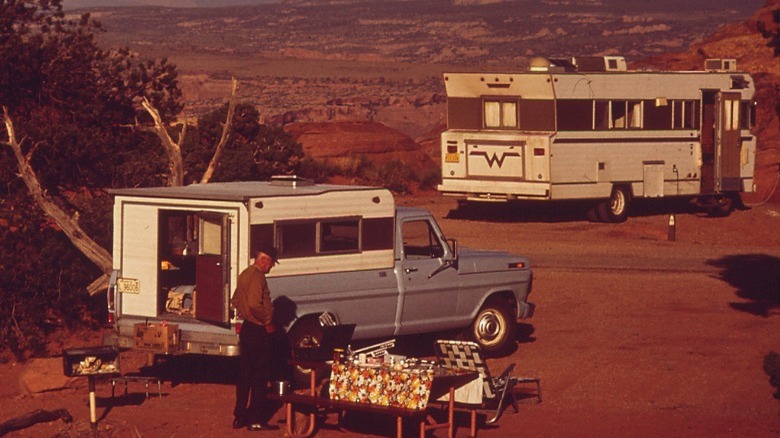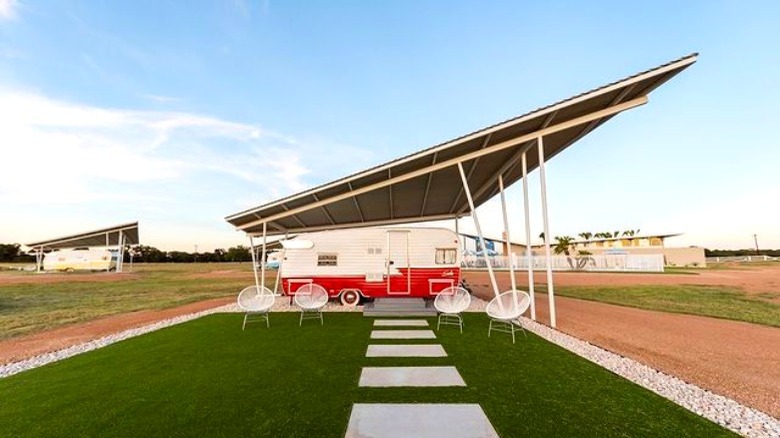The Untold Story Of The First RVs
There's something completely American about RV camping. Trailering or driving, RVs allow us to explore the great campgrounds, national parks, and the expanse of territory of the United States in a way that no other country really embraces. Whether the silver bullet Airstreams, pop-up tent campers of the '70s, or plush modern motorhomes, Americans love their RVs. And their popularity just continues growing. Business Insider reports that Americans bought $20 billion of recreational vehicles in 2018 alone, with AARP reporting that interest in traveling by RV has exploded during the Covid-19 pandemic.
But like everything else motor-vehicle-related, it's a relatively new national pastime, with its earliest incarnations coming about at the beginning of the 20th century. As the automotive industry was erupting in the early 1900s, and the Lincoln Highway was being built in 1913 to cross the country from San Francisco to New York, the interest in camping, and often car camping, began to build. But with few available roadside lodging opportunities outside of large cities, people began car camping, often with tents that attached to the sides of their Model Ts, sort of like a lean-to.
The first RVs were only a semblance of what we think of today
It could be argued that one of the first true RVs was the Pierce-Arrow Touring Landau (via History Garage). First available on the market for sale in 1910, it was a bit of a hybrid car/RV in a class known as "auto campers" or "camping trailers." It had some amenities we think of now with campers, like a backseat that folded into a bed, a pull-down sink with water provided from a pressurized tank, and a chamber pot "toilet," with storage for five suitcases on the back. It even had an internal telephone system, Smithsonian Magazine writes, that let the driver communicate with his passengers. However, it was nevertheless still just a glorified touring car.
As RV historian David Woodworth told the RV Industry Association, "The 1910 RVs offered minimal comforts compared to today's homes-on-wheels. But they did provide the freedom to travel anywhere, to be able to get a good night's sleep and enjoy home cooking." The simplicity of RV camping also appealed to travelers. As Smithsonian Magazine quotes one 1920s enthusiast, you just had to "let down the back steps and the thing was done."
While the Touring Landau was received positively, it was expensive, just like Pierce-Arrow's other luxury vehicles, RK Motors writes. So when the Great Depression hit and a lot of wealthier buyers lost their shirts in the stock-market collapse, demand for luxury vehicles, including RVs, collapsed with it, and the company went under in 1938.
One of the first RVs was a custom-built monstrosity of ingenuity
After the Touring Landau, the next generation was closer to what we currently consider an RV. The vehicle was built for the family of Roland Conklin by his own Gas-Electric Motor Bus Company, a company co-owned with his brother, Stanley, formed expressly to manufacture motorized trucks, Coach Built reports. Twenty-five feet long and 8 feet wide, somewhat resembling a double-decker bus, the vehicle was based on the traditional horse-drawn Romany "vardo" wagons that were basically fully equipped mobile homes (via Quality Unearthed).
Conklin called it a "land yacht," an apt description for the multi-story vehicle. Its massive size included sleeping berths for eight inside, with more on the upper deck. Every possible luxury available was incorporated, including an electric stove, a shower bath with hot water provided from the car radiator, electric lighting, a folding desk, a phonograph, convertible couches, and a rooftop garden (via Smithsonian Magazine).
It was such an unusual site that it drew headlines in The New York Times when it departed on its route, leaving from Huntington, Long Island on August 21, 1915, for a transcontinental trip ending in Los Angeles, where the family would return by steamer and the van would be shipped back on its own. People and press throughout the country flocked to see the Conklin Van, Smithsonian notes, and for many, it was their first look at a modern RV.
The Depression busted the RV market, and it wouldn't see a real resurgence for decades
The first official RV enthusiasts' group in the States was founded in 1919, Cruise America writes. Known as "Tin Can Tourists" for their tendency to weld tin cans to a car's radiator as poor man's cookstove to warm up food. History Garage notes that they were adventurers, driving on dirt roads, camping on roadsides, and generally sharing information.
However, the boom of the early teens and '20s in RV camping came to a screeching halt in 1929 when The Depression hit, Smithsonian Magazine writes, though they note that some who had become homeless ended up using smaller, inexpensive RV trailers as homes. With many struggling to get by, and formerly wealthy travelers now depleted of disposable income, the industry lagged. It began rebounding in the early '30s as more affordable models came on the market, like the Covered Wagon Company's "Covered Wagon" trailer offered for sale beginning in 1931 (via Tin Can Tourists), and the first Airstream trailers, also in 1931 (via their site).
Then, during World War II, much of the RV manufacturing was converted for wartime use to build things like mobile hospitals, and Covered Wagon Company was no exception. Rather than making RVs, they began making cargo truck bodies for the federal government. At the end of the war, the company failed to convert back to RV-making and collapsed, fading into historical obscurity.
The post-war era saw a boom in the RV industry
Once the war was over, and GIs flooded back into the country, eager for cheap vacations and easy entertainment, the popularity of RVs surged again. In part, the burgeoning interest in RV traveling mirrored the building of the Interstate Highway System. While associated primarily with President Eisenhower, who signed the Federal-Aid Highways Act of 1956 officially creating the Interstates, History reports that plans to build a transcontinental highway system had actually begun in 1939 when a report to Congress on "Tolls Roads and Free Roads" recommended that improvements were needed to the country's system of roads for national security reasons (via the FHWA). The Federal-Aid Highway Act of 1952 authorized the first funding for its construction. When the highway system was finally built, it allowed for easier long-distance travel, and let vacationers drive almost anywhere, a perfect scenario for RV tourism.
RV trailers were most popular among enthusiasts, primarily, as Smithsonian Magazine notes, because they were able to be separated from the car so it could be independent of the RV. Also motorhomes were unwieldy and didn't do well on the early roads. But when the highway system came along, so too did the growth in motorhomes. While they were growing in popularity in the '50s, it wasn't until Winnebago released its first affordable motorized RVs in 1967, offering five models in differentiating size and price points, that drivable RVs burst onto the scene in popularity, according to Smithsonian Magazine.
People are still passionate for vintage RVs
The Tin Can Tourists group of the 1920s still exists today, holding rallies, sharing information, and supporting the restoration of vintage RVs and motorhomes.
For those who don't want the hassle of owning a vintage RV trailer, but want to have a nostalgic experience, a number of camper camps have been popping up around the country that let you experience the joy of vintage RV life in beautifully renovated style, including Blue Skies Retro Resort, just north of Fredericksburg, Texas and The Vintages Trailer Resort in Dayton, Oregon, about 30 miles southwest of Portland. Both contain a number of retro campers.
But the American love for the RV lives on, whether vintage or modern. As David Woodworth, a long-time RV enthusiast, told Smithsonian Magazine, "RVs have changed, but the reason people RV has been constant the whole time." To Woodworth, it's all about the lifestyle and ease of camping in an RV. The bonus of traveling in an RV? He states, "You can stop right where you are and be at home."
